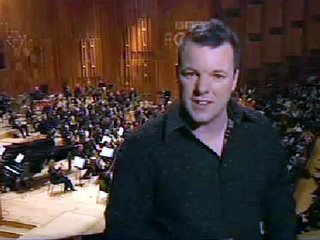 Modern orchestra concerts are steeped in silly ritual.
Modern orchestra concerts are steeped in silly ritual. The players' dress and behavior. The conductor's entrance. The audience remains very silent but applauds loudly during the gracious bows and curtain calls.
John Cage's piece 4'33" (it asks for complete silence from the performers) is
one of 20th century music's coolest ideas. It tells us that musical sounds come from anywhere, not just from musical instruments on stage. Squeaky door or squeaky violin. For many people, including me, this was a very liberating concept.
 But Cage combined his idea with a silly joke
But Cage combined his idea with a silly joke. He divided the silence into three movements - a very historical "frame" around the ambient sound - the same frame in which we hear classical concertos. Hey, it combines materials of the present with formal structures of the past. Most music does that.
I ran across a video of (get this)
a full orchestra performance of 4'33" - televised live by the BBC. The BBC Symphony orchestra (looking very relaxed probably because they were were being paid an infinite amount of money per note) was conducted by Lawrence Foster - who went through all the motions - including wiping sweat off his brow.
Here's a press release. ("A weekend of
musical mayhem.") The video is available
HERE(scroll down) and also
HERE. Here is a
REVIEW which reports that the orchestra tuned their instruments prior to the performance.

I found this performance pretty boring, actually. Even at high volume there wasn't much sound during the "movements". A couple of coughs and some hum. The large audience, dutifully trained in concert ritual, sat still as church mice. But
between movements the sound was much more interesting - the audience shuffling and coughing. And applauding rapturously at the end to gracious bows and curtain calls. Everyone knew just what was expected of them. Cage would probably have been thrilled to have his music performed this way.
I think someone seriously missed the point. In such an antiseptic, indoor concert-hall environment with all the formal staging, 4'33" became little more than a group of people holding their breath. Afterwards the BBC's "colour commentator" remarks on "
How much tension it generated. You could cut the atmosphere with a knife." They might have considered doing it outside where a car might have backfired or a dog barked. And in the January cold the conductor might have been excused for taking the tempo a bit faster.
The most interesting performance of 4'33" is probably the one you're about the perform - starting now. Here's a MIDI performance (in one movement) to help you get started. Chuckle.
 I'm awarding a Docker for the silly seriousness of this performance
I'm awarding a Docker for the silly seriousness of this performance to be shared among the programmers of the festival, the orchestra, the conductor, the BBC and the audience. If anyone needed proof that John Cage, America's great philosopher masquerading as composer, is now accepted into the canon of classical music - here it is. And if anyone wants to stretch another of his ideas to the breaking point, they'll have a hard time competing with this.
ASLAP notwithstanding.
What I'm really curious about, however, is where the young John Cage of today is.
Is some young composer out there creating musical ideas that will challenge the next half-century the way Cage challenged the previous one? We can only hope. And in 50 years will the BBC have a festival of that composer's music, thus repeating the cycle and obscuring the point. Yeah, probably.
Music Reviews
Music Video
 Saturday, as Leslie and I were driving home from LAX at the end of her trip to Mexico, we watched two hawks, drifting lazily higher and higher on an air column. This was happening exactly at the Four Level Interchange - the very heart of our magnificent, disfunctional freeway system that makes urban sprawl and low population density (where nearly everyone has a detached house and a front and back yard) possible.
Saturday, as Leslie and I were driving home from LAX at the end of her trip to Mexico, we watched two hawks, drifting lazily higher and higher on an air column. This was happening exactly at the Four Level Interchange - the very heart of our magnificent, disfunctional freeway system that makes urban sprawl and low population density (where nearly everyone has a detached house and a front and back yard) possible. Just to fill out the scene, the other picture was taken on a freeway.
Just to fill out the scene, the other picture was taken on a freeway.

















